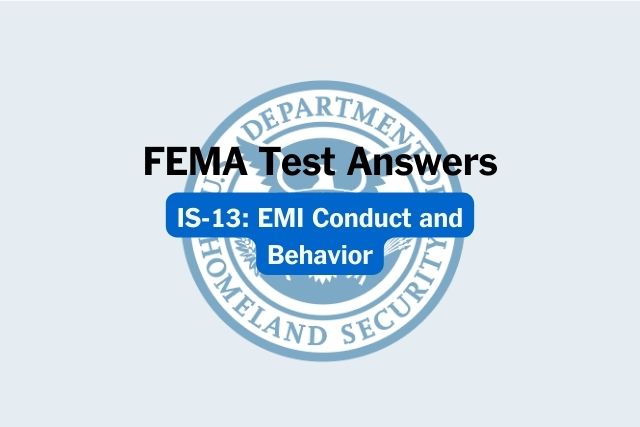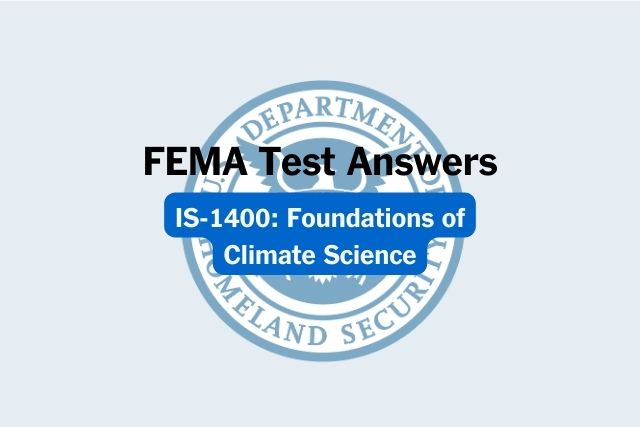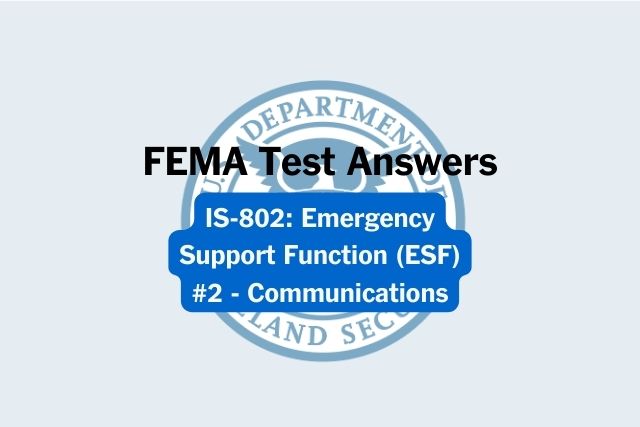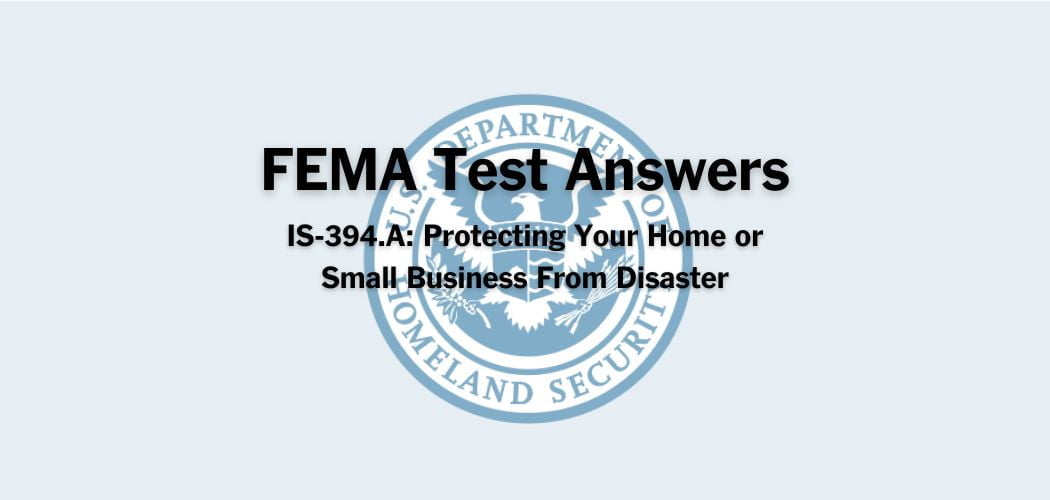Overview: The FEMA IS-251.A course was published on 3/17/2020 to provide information on Integrated Public Alert and Warning Systems (IPAWS) for Alerting Administrators.
FEMA IS-251.A test answers
Each time this test is loaded, you will receive a unique set of questions and answers. The test questions are scrambled to protect the integrity of the exam.
Question 1. For effectiveness when composing an alert, avoid using words with __________.
A. a distinct meaning
B. a clear interpretation
C. an easily understood meaning
D. different contextual or connotative meanings✅
Question 2. The ability to alert the user if the certificate is expired is a(n) __________.
A. security protocol
B. suggested IPAWS alerting software feature✅
C. recommended IPAWS permission
D. security update
Question 3. Alerting Administrators need to understand how the public reacts to receiving an alert and will need to incorporate this understanding into __________ which guides how and when IPAWS is used.
A. training plans and procedures
B. plans, policies, and procedures✅
C. exercises and processes
D. key components, policies, and message templates
Question 4. Your alerting tool should allow you the ability to _______.
A. constrain event types and geo-codes based on user permissions✅
B. attach a video file
C. support live digital certificates only
D. send one alert on a single isolated pathway
Question 5. _______ recommend(s) that Alerting Administrators take IS-251, IPAWS for Alerting Administrators.
A. Alerting Authorities
B. The Federal Emergency Management Agency (FEMA)✅
C. State and tribal authorities
D. Alerting Originators
Question 6. When establishing plans, policies, and procedures with respect to use of IPAWS, Alerting Administrators should consider the specific capabilities of their _______.
A. templates
B. guidance
C. alert and warning software tools✅
D. community
Question 7. Individuals with _______ needs may require alerts in varying formats. An example of an IPAWS initiative to improve accessibility is the symbology designed in collaboration with the National Alliance for Public Safety GIS (NAPSG).
A. access and functional✅
B. safety and functional
C. financial and safety
D. multiple cultural
Question 8. Which of the following is NOT a part of the four-step process for applying for IPAWS?
A. Complete IPAWS web-based training.
B. Apply for public alerting permissions.
C. Apply for a Memorandum of Agreement (MOA).
D. Demonstrate alerting proficiency in the IPAWS Training and Demonstration Environment (also referred to as the IPAWS TSSF Environment) by successfully sending an alert.✅
Question 9. IPAWS also supports _______ to redistribute alerts via desktop alerting, mobile applications, digital signs, etc.
A. Common Alerting Protocol (CAP)
B. Emergency Alert System (EAS)
C. Primary Entry Point (PEP)
D. Internet-based services✅
Question 10. Alerting Authorities originate alerts to IPAWS to be disseminated through which of the following pathways?
A. Wireless Emergency Alerts (WEA), Emergency Alert System (EAS), and State/Local Unique Alerting Systems (UAS).
B. The Weather Channel, National Weather Service, and Emergency Alert System (EAS).
C. National Oceanic and Atmospheric Administration (NOAA), and Internet Services.
D. Emergency Alert System (EAS), Wireless Emergency Alerts (WEA), National Weather Emergency Messages (NWEM).✅
Question 11. Keeping well-developed, up-to-date procedures is important because they _______.
A. provide step-by-step guidance for issuing an alert which contributes to effective alerting practices
B. identify roles and responsibilities of alerting authorities for clarity of IPAWS software use✅
C. establish the rules of behavior for use of IPAWS software which guides IPAWS software security practices
D. are definite courses of action adopted for the sake of expediency or facilitation
Question 12. Hands-on training provides the opportunity to _______.
A. access your alert origination tool, practice sending live alerts, observe dissemination, and evaluate procedures that you may implement at your facility
B. access your alert origination tool, practice Emergency Alert System (EAS) and Wireless Emergency Alert (WEA) activation, create user logins for your team, and evaluate procedures that you may implement at your facility
C. access your alert origination tool, practice event code activation, observe dissemination and evaluate procedures that you may implement at your facility
D. access your alert origination tool, practice Emergency Alert System (EAS) and Wireless Emergency Alert (WEA) activation, observe dissemination, and evaluate procedures that you may implement at your facility✅
Question 13. A Memorandum of Agreement (MOA) is a(n) _______.
A. document generated after a Collaborative Operating Group (COG) has successfully completed the application process
B. written understanding of the Rules of Behavior regarding the use of IPAWS which provides applicable agency information✅
C. application that must be signed by more than one individual listed in the points of contact (POC) section
D. agreement between software vendors and Collaborative Operating Groups (COGs) required prior to the purchase of IPAWS-compatible software
Question 14. In order to successfully send a Wireless Emergency Alert (WEA), an alert must adhere to all of the following EXCEPT
A. urgency
B. certainty
C. duration✅
D. severity
Question 15. As an Alerting Administrator, it is imperative you make plans that factor in _______.
A. citizens with special needs
B. all populations in your community✅
C. tribal communities
D. isolated populations
Question 16. The following list contains examples of _______.
• Secure login and password
• Ability to assign user-level permissions
• Ability to originate a Common Alerting Protocol (CAP) alert/message
• Displays connectivity to IPAWS
A. software changes
B. security protocols
C. user access controls
D. suggested alerting tool elements✅
Question 17. The Emergency Alert System (EAS) is one of several message dissemination pathway(s) that send(s) warnings via broadcast, cable, and wireline services after those warning messages are processed through _______.
A. Primary Entry Point (PEP)
B. The IPAWS Open System✅
C. Wireless Emergency Alerts (WEA)
D. Common Alerting Protocol (CAP)
Question 18. Alerting authorities need to know which codes require _______ to be sent out.
A. prior approval
B. human intervention✅
C. automatic dissemination
D. tribal, state, or local authorization
Question 19. Accessibility of alert and warning messages refers to whether _______.
A. all individuals read and interpret alerts
B. all individuals can receive and understand alerts✅
C. all individuals hear alerts
D. all individuals understand alerts
Question 20. IPAWS alerting software should provide an Alerting Administrator with the ability to configure User permissions based on _______.
A. expressed need for access
B. ability to issue alerts
C. roles and responsibilities of personnel✅
D. risk of errant alerts
Question 21. Which of the following is a specific feature applicable to Wireless Emergency Alerts (WEA)s?
A. Supports up to 360 characters.✅
B. Supports video.
C. Alerts are confined to the boundaries of the state issuing the message.
D. Supports two-way communication.
Question 22. Which of the answer choices should be offered by your vendor to support effective IPAWS use?
A. New hire training only since refresher training can be provided internally.
B. Refresher training only to present updates.
C. Intuitive user manuals.
D. New hire and refresher training because they are both critical.✅
Question 23. Which of the following is a component of an effective alert message?
A. Standard Operating Procedures (SOP)✅
B. Consequences
C. Origin
D. Local evacuation plans
Question 24. Who should require agency personnel to conduct regular training, practicing, and exercising as it relates to agency IPAWS policies and procedures?
A. Alerting Administrators✅
B. State IPAWS Authorities
C. Collaborative Operating Groups
D. IPAWS Program Management Office
Question 25. A Memorandum of Agreement has a _______ lifecycle.
A. 1-year
B. 3-year✅
C. 4-year
D. 2-year
Question 26. It is important to establish agreements with adjacent jurisdictions that address the coordination of alerts to enable a(n) _______.
A. stable response
B. coordinated and consistent response in advance✅
C. a consolidated and calm approach to the incident
D. consistency in planning
Question 27. _______ are a technical requirement of IPAWS to process Wireless Emergency Alerts (WEA)s.
A. Message types
B. Event codes
C. Watches and warnings
D. Handling codes✅
Question 28. _______ should be set up based on your agency’s requirements, local hazards, and what works best for your jurisdiction.
A. Collaborative Operating Groups (COGs)✅
B. Intra-agency staffing procedures
C. Wireless Emergency Alerts (EAS)
D. Plans, policies, and procedures
Question 29. _______ enacts to law the policy statement along with similar requirements found in Executive Order 13407 and required the Federal Emergency Management Agency (FEMA) to establish a National Advisory Council (NAC) IPAWS subcommittee to ensure the public alert and warning system would meet certain specified standards.
A. Public Law 93-288, The Stafford Act
B. Executive Order 13407 – Public Alert and Warning System
C. Section 706 of 47 U.S.C. 606, Priority Communications – War Powers of the President
D. Public Law 114-143, The IPAWS Modernization Act✅
Question 30. Which of the following is a benefit of training, practicing, and exercising your alerting tool?
A. Identifying gaps in plans, policies, and procedures.✅
B. Producing coordinated and erratic responses to alerts.
C. Demonstrating jurisdictional effectiveness in alert evaluation.
D. Practicing in the IPAWS environment.
Question 31. To ensure a Collaborative Operating Group (COG) is capable of composing and sending a message through IPAWS, demonstrations must be performed on a regular basis through generation of a message successfully sent through the _______.
A. Virtual IPAWS TSSF
B. IPAWS Live System
C. IPAWS Training and Demonstration Environment✅
D. IPAWS Message Viewer
Question 32. Alerting Administrators need to be familiar with software vendor processes for installation of _______ to alerting software.
A. new updates and changes
B. user interfaces
C. access controls
D. security protocols✅
Question 33. Participants demonstrate alerting proficiency in the _______.
A. IPAWS Training and Demonstration Environment✅
B. local emergency communications policies and plans
C. coordination of tribal, state, and local jurisdictions
D. use of IPAWS compatible software
Question 34. What elicits a quicker response to alert and warning messages?
A. Time of day
B. Anticipated support from the Federal Emergency Management Agency (FEMA)
C. Future expectations
D. Concern for children and pets✅
Question 35. What handling codes are considered a requirement of IPAWS to process a Wireless Emergency Alert (WEA)?
A. • Presidential
• AMBER
• Imminent Threat
• Public Safety
• WEA Test✅
B. • Radiological Hazard Warning
• Imminent Threat
• AMBER
• Public Safety
• WEA Test
C. • Presidential
• Public Safety
• Emergency Alert System (EAS) Test
• Emergency Action Notification
D. • Presidential • AMBER
• Imminent Threat
• Public Safety
• Civil Emergency
Question 36. The IPAWS aggregator _______.
A. is the pathway that sends warning via broadcast, cable, and wireline services✅
B. processes messages to be disseminated via various communications pathways
C. provide a single input to activate multiple alerting and public warning systems
D. provides an open, non-proprietary digital message format for all types of alerts and notifications
Question 37. When different people listen to the same message, there may be a _______ in what they hear, leading to a different interpretation and response.
A. uniform clarity
B. similar understanding
C. common interpretation
D. variation✅
Question 38. Authorized alerting authorities send _______ through the Federal Emergency Management Agency’s (FEMA) IPAWS to participating wireless carriers, which then broadcast the alerts from cellular towers to mobile devices in affected areas.
A. Common Alerting Protocols (CAPs)
B. Wireless Emergency Alerts (WEAs)✅
C. Emergency Alert Systems (EAS)
D. Primary Entry Points (PEPs)
Question 39. What is the title of the individual assigned to initiate an IPAWS alert using CAP-capable software?
A. Alert Originator✅
B. Alert Authority
C. State Alert Agents
D. Alerting Administrator
Question 40. When developing plans, policies, and procedures, Alerting Administrators can mitigate risks and vulnerabilities by considering internal stakeholder _______.
A. contributions and concerns✅
B. interests and engagement
C. formal training and systems knowledge
D. capabilities and expertise
Question 41. Emergency Alert System (EAS) participants deliver local alerts on a(n) _______ basis, but they are required to provide the capability to address the public during a national emergency.
A. mandatory
B. as needed
C. regulated
D. voluntary✅
Question 42. It is imperative that all _______ stated within the Memorandum of Agreement (MOA) remain current in order to provide and receive pertinent IPAWS information.
A. Rules of Behavior
B. Applicable Funding Streams
C. Habits of Authority
D. Points of Contact (POC)✅
Question 43. List the five Wireless Emergency Alert (WEA) message types.
A. Presidential, AMBER, Emergency Action Notification, public safety, and WEA test
B. Presidential, law enforcement warning, imminent threat, public safety, and WEA test
C. Presidential, AMBER, imminent threat, public safety, and Emergency Action Notification
D. Presidential, AMBER, imminent threat, public safety, and WEA test✅
Question 44. Who supports nation-to-nation tribal relationships and recognizes the unique cross-jurisdictional challenges they face with emergency management and public alerting?
A. Bureau of Indian Affairs
B. Native American tribal governments
C. The governor of each state
D. The Federal Emergency Management Agency’s (FEMA) National Tribal Affairs Advisor✅
Question 45. Which answer choice is one of the four steps in the process of applying for IPAWS?
A. Select IPAWS compatible software.✅
B. Demonstrate alerting proficiency in the IPAWS Training and Demonstration Environment (IPAWS Lab).
C. Acquire state approval.
D. Successfully complete an IPAWS procedure assessment.
Question 46. What is an Alert Authority?
A. Individual who utilizes agency plans, policies, and procedures to validate IPAWS messages.
B. Person or entity who ultimately receives an IPAWS message.
C. A jurisdiction with the designated authority to alert and warn the public.✅
D. Person who creates documents accurately to get the desired reaction from the public.
Question 47. Which of the following is NOT a means of accessing the IPAWS Training and Demonstration Environment (also referred to as the IPAWS TSSF Environment)?
A. Virtual IPAWS TSSF access
B. IPAWS TSSF satellite campus✅
C. Onsite IPAWS TSSF use
D. IPAWS Message Viewer
Question 48. Which of the following is an external stakeholder that provides valuable input and expertise to the establishment of agency policies, plans, and procedures regarding the implementation of IPAWS?
A. Intra-agency staff
B. Public safety personnel
C. Universities and colleges✅
D. Alternate and technical points of contact
Question 49. Alerting Administrators should implement and employ applicable _______ to control access to IPAWS alert and warning software.
A. alert privileges
B. training scenarios
C. current system updates
D. security protocols✅
Question 50. The attributes below best describe the _______:
• User-friendly web interface
• Available 24/7
• No need to schedule time with IPAWS TSSF personnel
A. virtual IPAWS TSSF
B. IPAWS Message Viewer✅
C. IPAWS Demonstration System
D. IPAWS TSSF
Question 51. Web, computer, and/or video training should be available to users as a regular refresher on the processes and procedures of using the software. This training should be available from the vendor at least _______.
A. daily
B. monthly
C. annually✅
D. weekly
Question 52. Alerting Authorities must ensure their Collaborative Operating Group (COG) demonstrates the ability to compose and send a message through the IPAWS system at regular intervals. Therefore, demonstrations must be performed _______.
A. weekly
B. monthly✅
C. annually
D. bi-weekly



